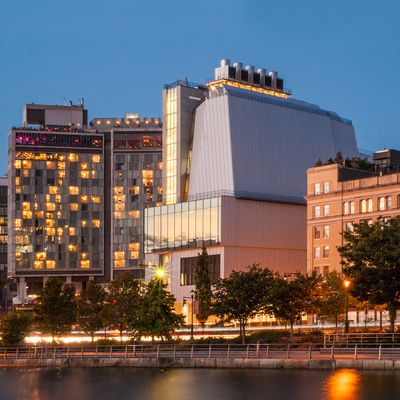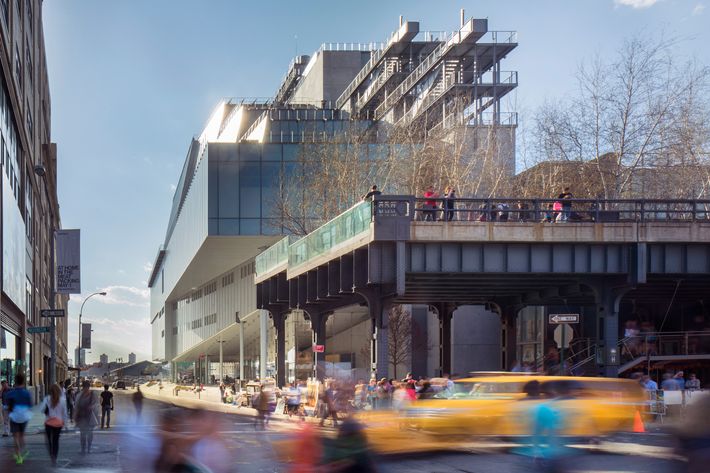
The 220,000-square-foot Whitney Museum opened May 1 and is already a huge success. ItÔÇÖs almost three times as big as the dark old Breuer Building uptown, sun-lit, praised by critics and thronged with tourists. The oddball outside of the Renzo Piano building might be a bit controversial, but maybe that can be fixed with a deft addition: After all, the Whitney, like all museums in the city these days, has a plan to get bigger, too. The only question is how soon theyÔÇÖll get to it.
ItÔÇÖs good to remember that the Whitney is only downtown because it was frustrated for decades by a plan to expand on Madison. Remember the 1985 Michael Graves proposal? Or the crazy spaceship idea from Rem Koolhaas in 2001? Or even the comparatively demure 2004 Madison Avenue annex designed by Renzo Piano, before the High Line came calling? The fact is, the new Whitney comes with an option to get bigger: the low-slung meatpacking facilities just to the north (including the beloved little greasy spoon HectorÔÇÖs Caf├® & Diner). Sure, the current tenants have leases with the City of New York, which owns the buildings through 2031 ÔÇö but then the Whitney has the right of first refusal on the property. So it might not be for a while, but it seems that eventually, the steaks will go, replaced by prime cuts of art history. Just blow out the north-facing wall (now home to, among other things, the curatorÔÇÖs offices) and let Piano compose something even bigger.
Because, you see, everyoneÔÇÖs expanding these days. Just a decade after MoMAÔÇÖs yearlong shutdown for a face-lift, the brass started asking to knock down buildings to make more space, and nobody seems that happy about it. There are some serious squabbles happening on the Upper East Side over the Frick expansion. But more people than ever are going to art museums, and the Whitney is perfectly situated to attract some of the cityÔÇÖs ever-expanding number of tourists.
I asked Adam Weinberg, the Alice Pratt Brown director of the Whitney, about expansion at one of the black-tie galas that inaugurated the Renzo Piano building.
ÔÇ£IÔÇÖm not even going there at this point ÔÇö tonight is a night to enjoy where we are and then think about it later on,ÔÇØ he deflected.
When reached for official comment, a spokesperson for the Whitney provided the current statement: ÔÇ£Yes, the Whitney has right of first offer on the City-owned property to the north should it become available in the future, but having just moved into our building weÔÇÖre focused on settling into our wonderful new space.ÔÇØ
And so for now, in the shadow of their wonderful new space, the meat still gets cut.

ÔÇ£Tell the Whitney Museum, when they wanna expand, weÔÇÖll move tomorrow!ÔÇØ said one man on Washington Street when I stopped by the meatpacking plant at 9:00 a.m. The last of the meatpackers in the Meatpacking District were finishing their shifts, shooting the breeze, smoking cigars.
That museumÔÇÖs glittering new building was perched directly above, and behind him was his place of employment, a city-block-size fridge where carcasses were hung for butchering.
Another meat worker, taking lots of mini drags off his stogie, waddled over to chime in.
ÔÇ£WeÔÇÖll move whenever,ÔÇØ he said. ÔÇ£Just tell them to give usÔÇØ ÔÇö puff ÔÇö ÔÇ£elevenÔÇØ ÔÇö puff ÔÇö ÔÇ£millionÔÇØ ÔÇö puff ÔÇö ÔÇ£dollars.ÔÇØ
On the morning we stopped by, Tom Jobbagy was standing in his whites outside his meat enterprise J.T. Jobbagy, which he runs with his brother John. The smartly dressed early risers residing at the Standard, High Line, were hopping into Ubers on the cobblestoned street as Tom started telling me about the business. He and his brother come from a butcher family. Thomas, their grandfather, opened a meatpacking joint in 1925 just around the corner, at 352 West 14th Street (itÔÇÖs now a Coffee Bean). Their father, Edward, took over the operation and turned it into a first-class protein destination, shilling shanks to the best restaurants in town. Now the brothers get to work at 4 a.m. ÔÇö about when bottle service at Le Bain shuts down ÔÇö to deal with increased demand due to the dwindling number of shops left.
I was brought up into the locker, where John Jobbagy ÔÇö also in whites, and intense, with tough skin and none of the jocular approach of his cigar-chomping employees ÔÇö was sitting in his office, papers everywhere. I asked him about the incursion onto his turf of art works and the billionaires who buy them.
ÔÇ£I canÔÇÖt really say much about that ÔÇö IÔÇÖm a butcher, weÔÇÖre meat guys,ÔÇØ he said. ÔÇ£WeÔÇÖre not in the art world.ÔÇØ
But further probing showed that John had been in talks with the Whitney and might even be taken by its glitz. He allowed the staffers who planned the Whitney Block Party to use an image of his carcasses so hipsters could pose in front of it in meatpacking whites, Ray-Bans on. He claimed that board members had come by his place of business, curious and well intentioned. He also said that his cooperation with the city was integral to getting the WhitneyÔÇÖs move downtown approved, saying ÔÇ£the Whitney wouldnÔÇÖt be hereÔÇØ without their efforts. He dropped some names.
ÔÇ£IÔÇÖm personally very friendly with Adam,ÔÇØ Jobbagy said, meaning Adam Weinberg.
After John walked me out, I walked next door to HectorÔÇÖs, which has a quite wonderful location for a diner that fries up patties of chuck, what with it being next to the place that butchers the stuff. Regulars refer to the burger as the Jobbagy Burger.

Anyone whos been there can attest to its charm, and to the fact that it would be a crime to let anyone bulldoze it. Hectors is a place where, upon walking in, you see construction workers with Joisey accents barking mock come-ons to a waitress. You see tourists hunched over a map and speaking in hushed French. You see a kid talking to the chef in quick Spanish. Its always open, and they sell smokes. Plus, I had one of the greatest breakfasts of my life that day at Hectors. You can get a hulking plate of charred hash-browns, crisp eggs splattered over with yolk, nearly a loaf of butter-soaked toast, and two big sausage links halved and fried  and its all just $7.
At Santina next door, the crudit├® ÔÇö no more than a few fancy raw vegetables ÔÇö will run you $20. ItÔÇÖs going to be sad to see HectorÔÇÖs go.
ÔÇ£If they come with the right amount of money, IÔÇÖd be happy to leave,ÔÇØ Freddy Mangarraza, who was manning the cash register that morning, said. ÔÇ£Sometimes you have to, you have no choice.ÔÇØ
At least for now, Mangarraza said the WhitneyÔÇÖs instant popularity has made business spike, and thatÔÇÖs good news. ItÔÇÖs great to have a cheap option in whatÔÇÖs quickly becoming one of the more expensive stretches of urban living on Earth.
As for the last affordable nightlife option on Washington Street, that would probably be Hogs & Heifers, the 23-year-old honky-tonk where the waitresses wear bras and start dancing on the tables for a mix of finance guys and tourists┬áif the right tune comes on. Because it was a tad early for a shot and a beer that morning, I called Hogs & Heifers later to see if they could comment on how the Whitney could speed whatÔÇÖs looking to be an impending demise. They said to come in and ask in person, and slammed the phone down.
And I will come in, as long as itÔÇÖs still open.

